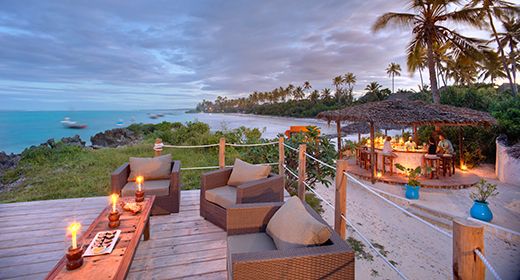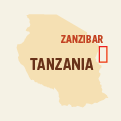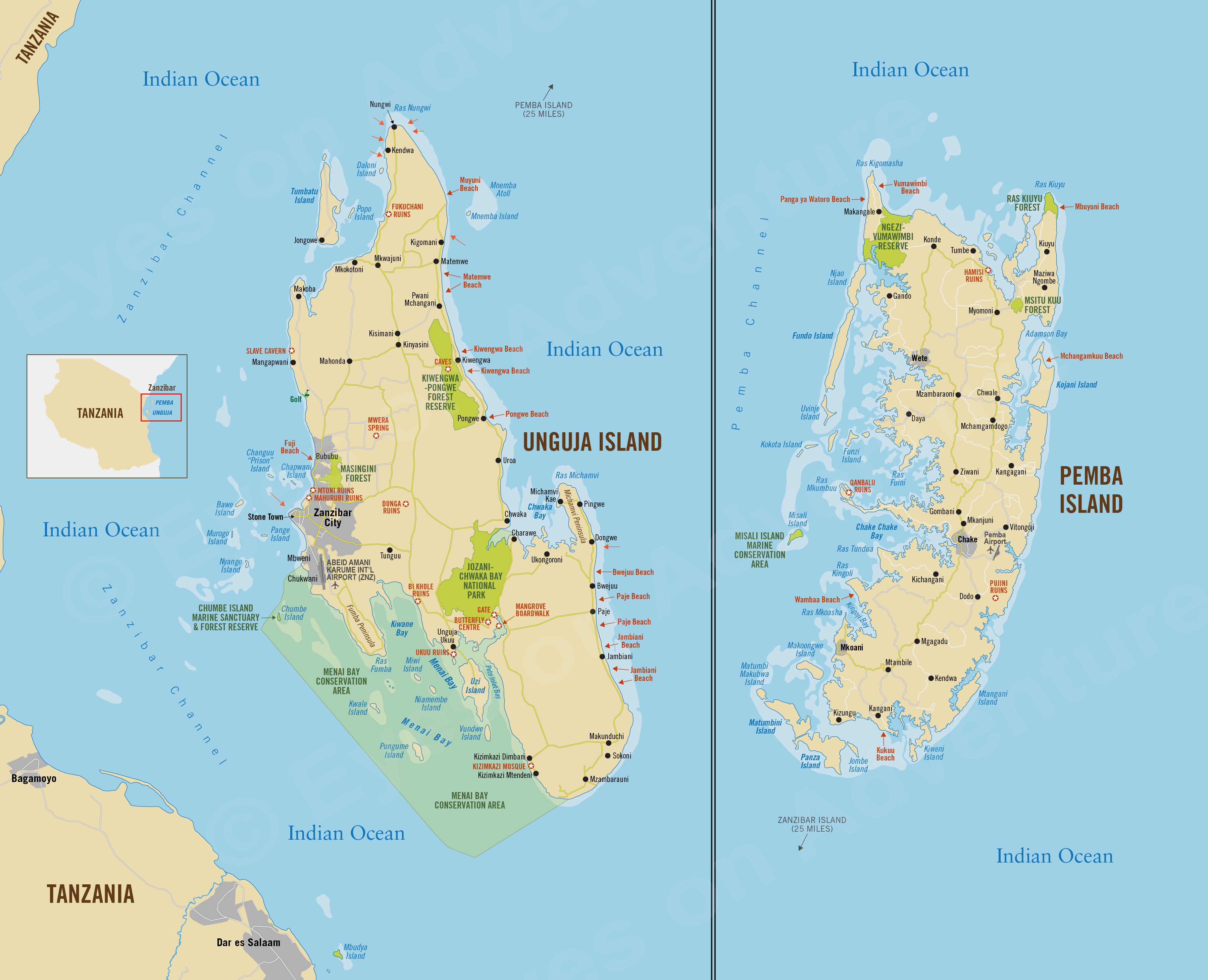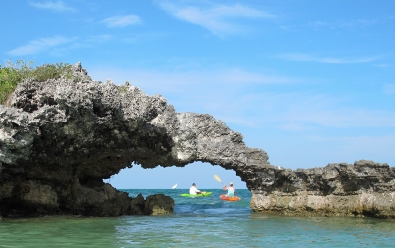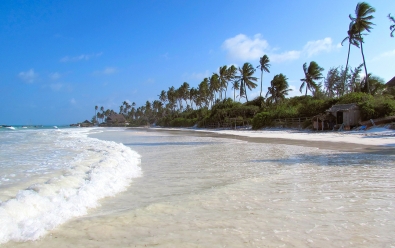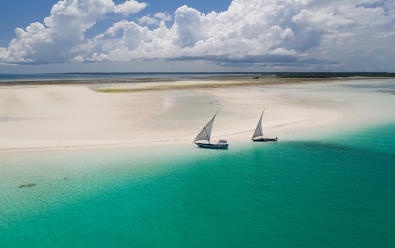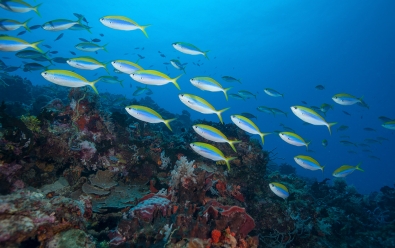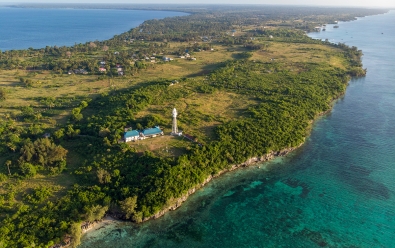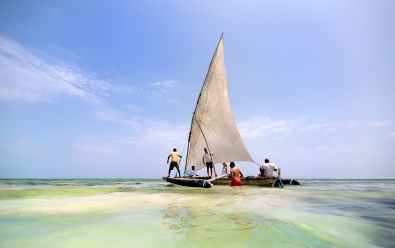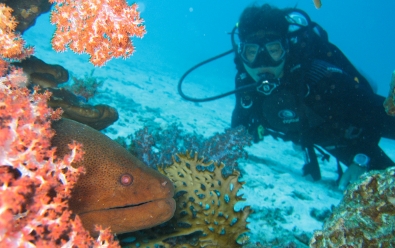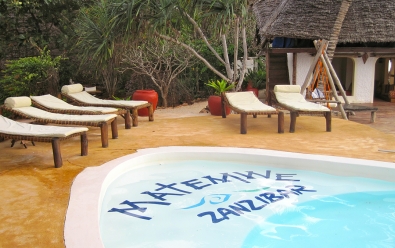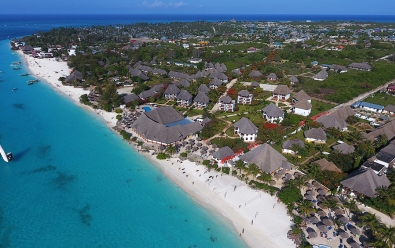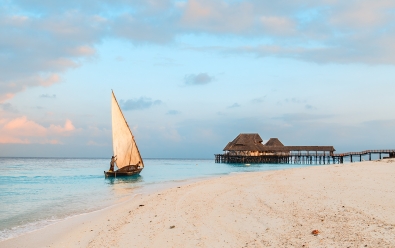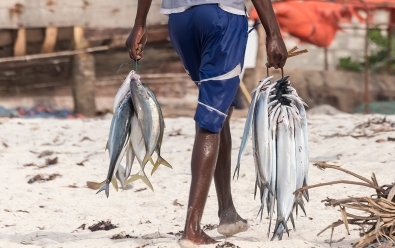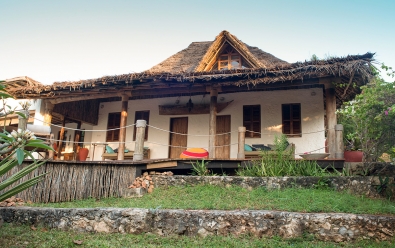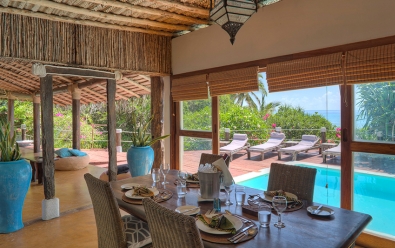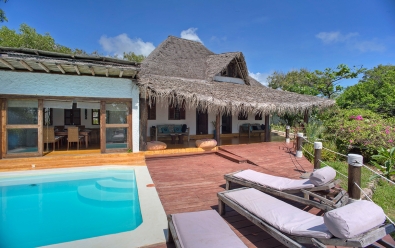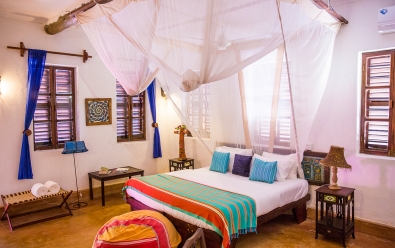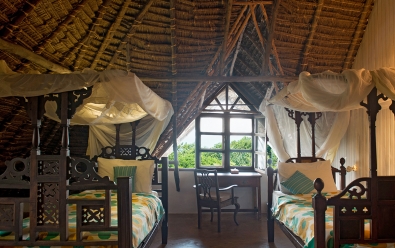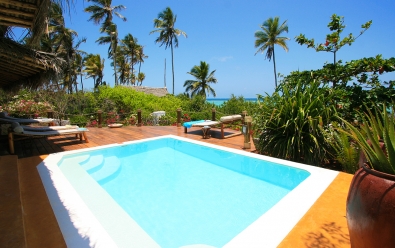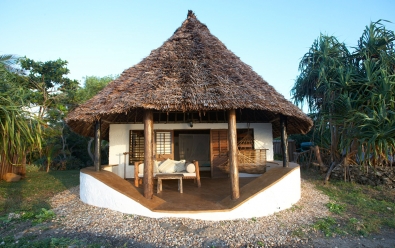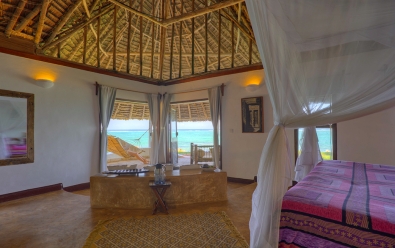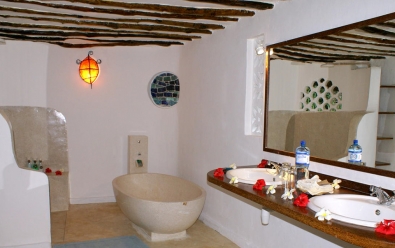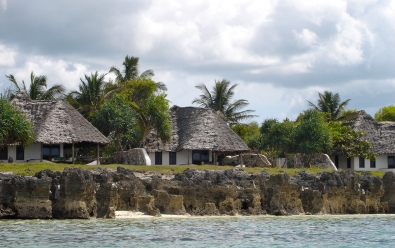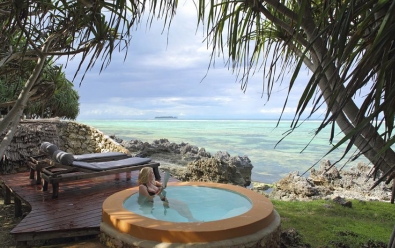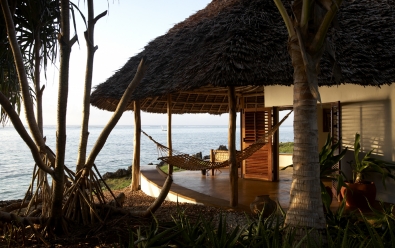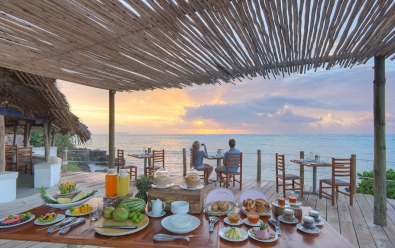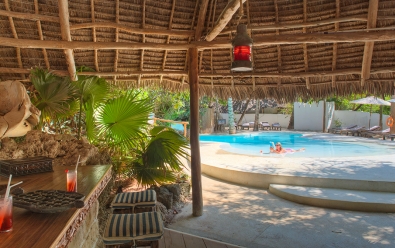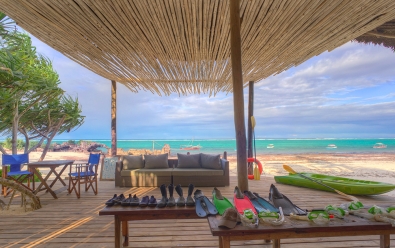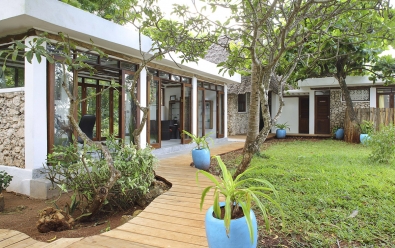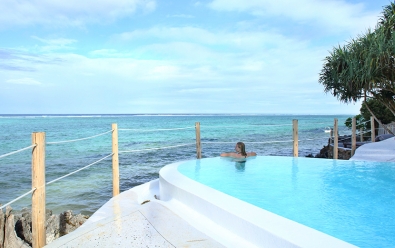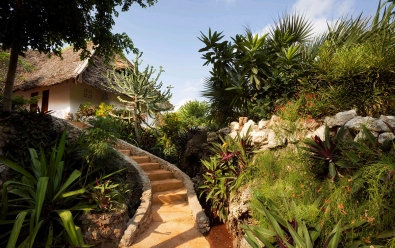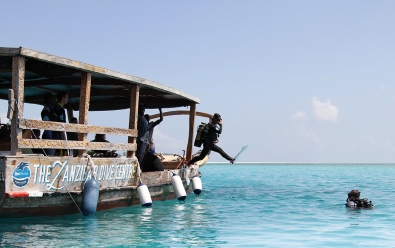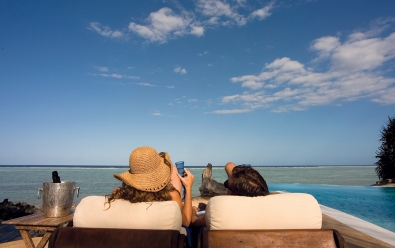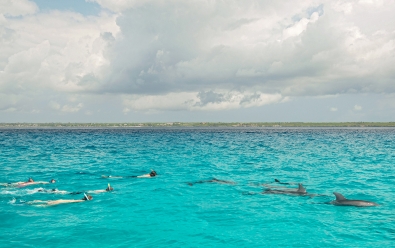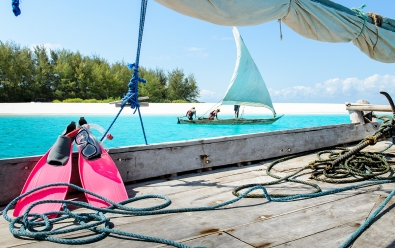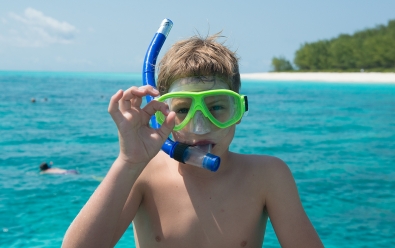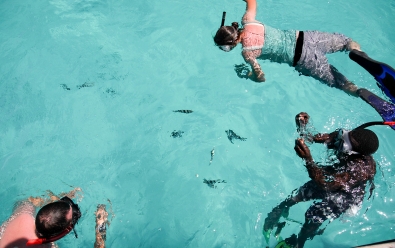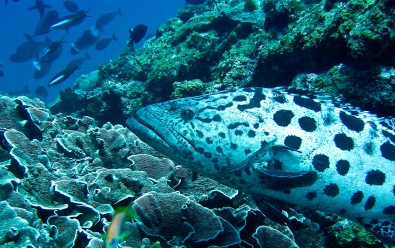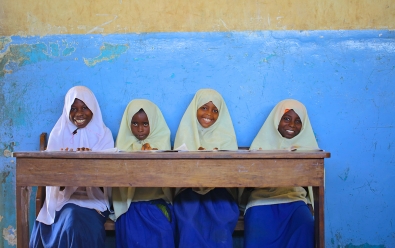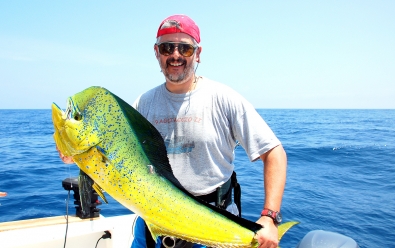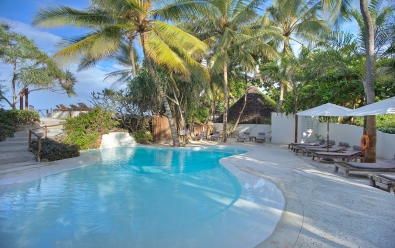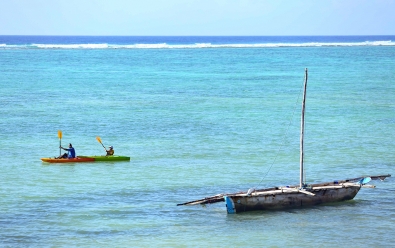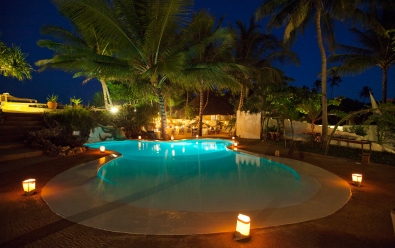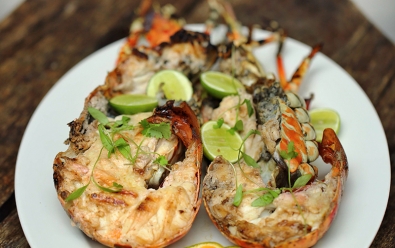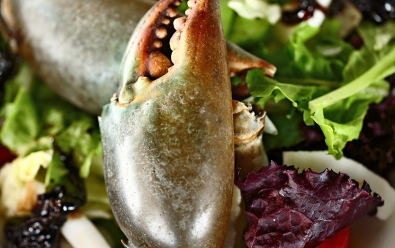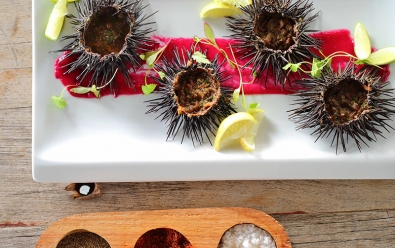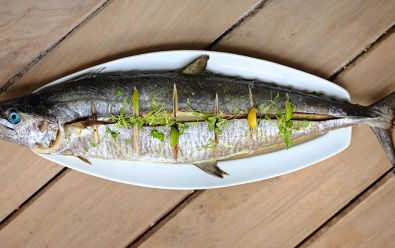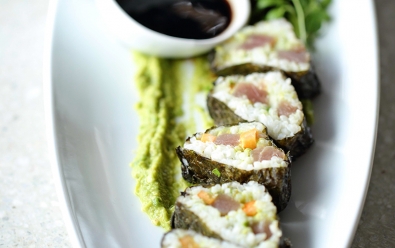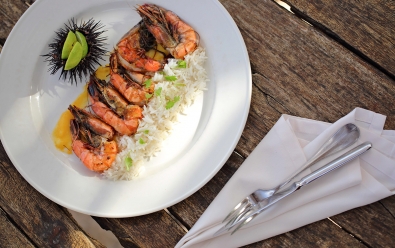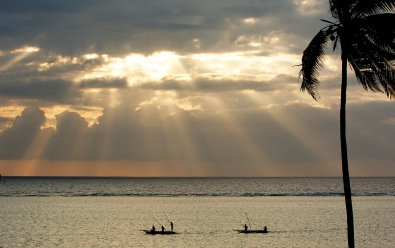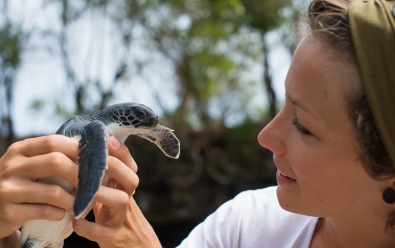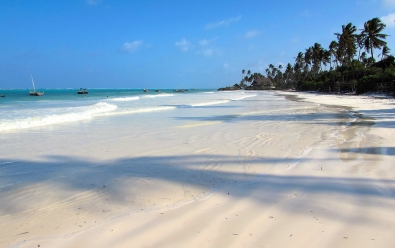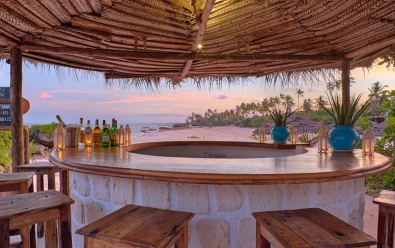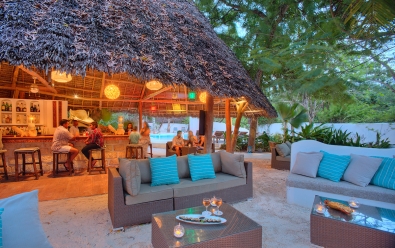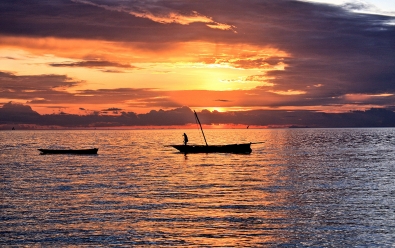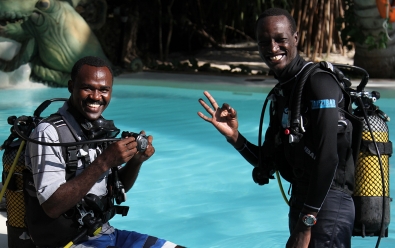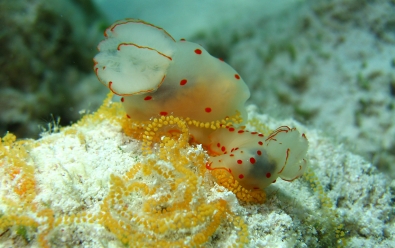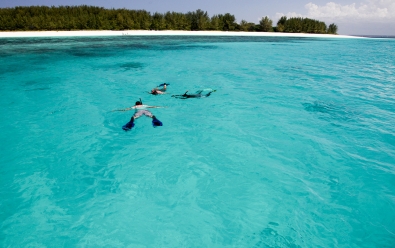Matemwe Lodge
Inquire for lodging prices
Highlights
- Tropical, Indian Ocean getaway with myriad activities
- Located on the uncrowded northeast coast of the island
- Access to nearby Mnemba Island for superb diving and snorkeling
- Fresh seafood and other dishes infused with Zanzibari flavors
Location
- Northeast coast Unguja Island
- Zanzibar Archipelago
- NE Tanzania / Indian Ocean
Matemwe Lodge is located on the quiet, northeast coast of Unguja Island overlooking a shallow, coral-fringed lagoon and surrounded by lush, tropical gardens and a white-sand beach.
Zanzibar is steeped in history, with centuries of Indian Ocean merchants from the Far East sailing its waters and trading spices, slaves, ivory, and items from the Orient. Zanzibar's exotic islands include beautiful beaches, tropical air, warm Indian Ocean waters and are home to a great diversity of cultures. A visit to the islands is a great add-on to a wildlife safari in East Africa.
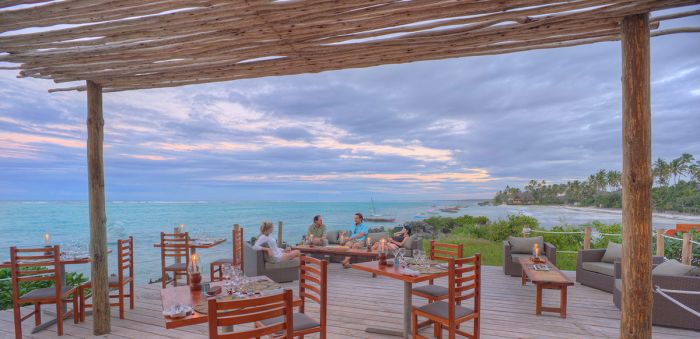
Outdoor dining space at Matemwe Lodge.
Matemwe offers 12 spacious ocean-front guest chalets, some of which have an upper-level mezzanine to accommodate a third guest. The chalets all look onto the azure Indian Ocean and offer complete privacy, with an outdoor veranda to while away time between activities.
There is also a private, three-bedroom villa designed for a family or small group that includes a dedicated butler and chef.
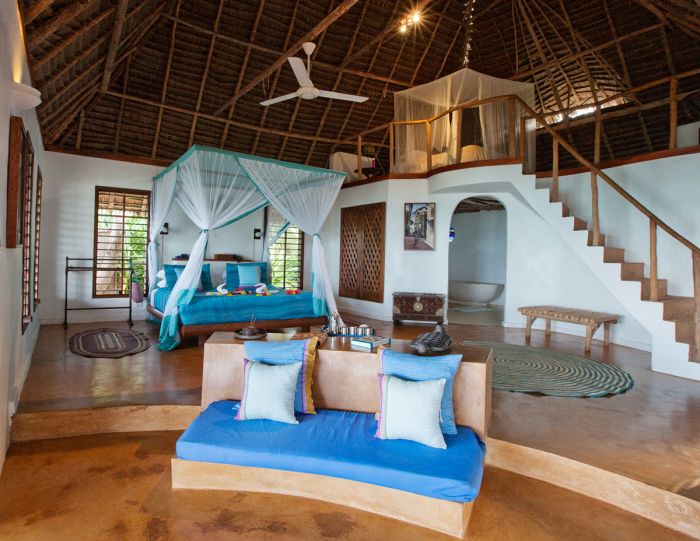
Guest villa interior at Matemwe Lodge.
The resort's main guests areas center around the open-air dining space, where guests can enjoy a variety of cuisines. The house specialty is Zanzibari seafood, with entrees prepared using fresh and locally-sourced fish, shellfish, and produce, many prepared with Zanzibar's distinctive flavors using spices grown on the islands. There are two swimming pools, a Water Sports Centre, a full-service spa, and two, open-air bars, one poolside and the other beside the beach.
The activities offered would require several weeks to exhaust, but some of the more popular include snorkeling, diving, paddle-boarding, kayaking, jet-skiing, catamaran and exotic sunset dhow cruises, and deep-sea fishing. Day trips include walking tours of historic Stone Town (a UNESCO World Heritage Site), local spice farm tours, and hikes in Jozani Forest to see the local bird life and hopefully the endangered and endemic Zanzibar red colobus monkeys. Check the details tab for a complete list.
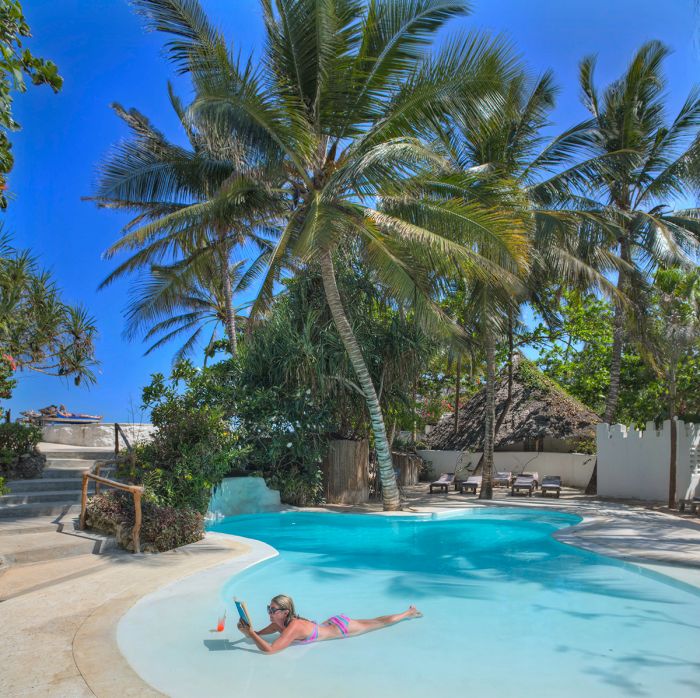
Main area swimming pool at Matemwe Lodge.
About Zanzibar
Zanzibar consists of two main islands and about 50 much smaller islands lying 25-50 miles (40-80 kms) offshore from the northern coast of Tanzania, which is known as the Swahili Coast.
Most of Zanzibar's population, which numbers around 1.1 million, live on its two largest islands, Unguja (also known as Zanzibar Island) and Pemba. Roughly two-thirds live on Unguja, while most of the rest live on Pemba. Small numbers live on Tumbatu, Fundo, and some of the other small islands in the archipelago.
Zanzibar is a semi-autonomous region belonging to the Republic of Tanzania, with its own government.
The Zanzibar Archipelago have long produced cloves, nutmeg, cinnamon, vanilla, and black pepper and together with Mafia Island further south along Tanzania's coast, are known as the "Spice Islands".
Read more about Zanzibar's history on our Zanzibar region page.
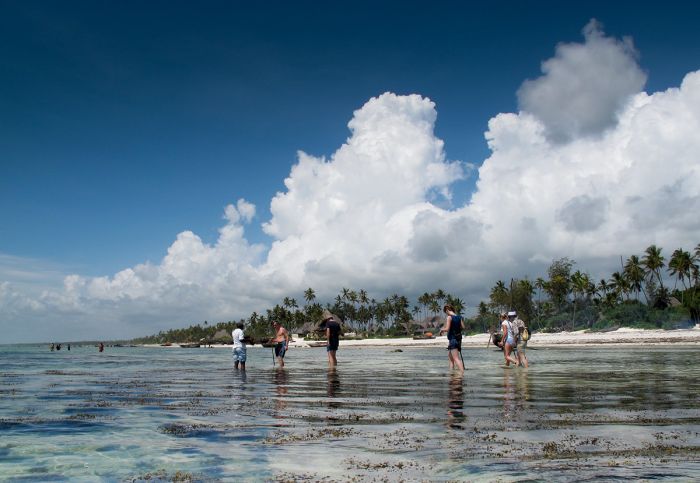
Low-tide reef walk at Matemwe Lodge.
Unguja Island
Unguja Island covers an area of 643 square miles (1 666 sq kms), measuring 53 miles (83 kms) north-to-south and 19 miles (30 kms) east-to-west at its widest. Zanzibar's capital is Zanzibar City, located on the west coast of Unguja and the only significant urban center on the islands. Zanzibar's top tourist draw is Stone Town, the old Arabian-style quarter of Zanzibar City.
The northern tip of Unguja, around the traditional fishing and dhow-building village of Nungwi, has become Zanzibar's most popular tourist retreat, owing to the myriad water sports available including superb snorkeling and diving. Once an enclave for hippies, Ras Nungwi has emerged as the place to be on Unguja, with a multitude of accommodations, seafood restaurants, and a lively nightlife scene.
Pemba Island
Located 25 miles (40 kms) northeast of Unguja lies Zanzibar's oft overlooked 'other' big island, Pemba. Often called the "Green Island", owing to its lush and densely vegetated landscape, the island covers an area of 381 square miles (988 sq kms), measuring 42 miles (67 kms) north-to-south and 14 miles (22 kms) east-to-west at its widest.
Pemba is infrequently visited, as it is not touted as a tourism destination by the Zanzibari government. Pemba's infrastructure is far less developed than Unguja, but is far quieter and retains a true old world feel. The island and its offshore reefs are best known for having numerous world-class dive locations. Pemba also offers lovely beaches and several ruin sites.
About Matemwe
Matemwe is one of the most pleasant beaches on the eastern shoreline, with palm trees, wide white sands, and intimate village life. The snorkeling and diving on the reef is superb.
About Nungwi
Located at the northern tip of Unguja Island, Nungwi is Zanzibar's most popular tourist retreat, with a multitude of accommodations, seafood restaurants, adventure sports operators, and an established nightlife scene.
The two main stretches of beach are located on the western side of the cape and this is where the hotels, restaurants, and bars are located. The coast between the villages of Nungwi and Kendwa is the hub of tourist activity and snorkeling, diving, windsurfing, dhow cruises, and other water-sports can be arranged from any accommodation. Diving can be booked at one of the PADI-accredited dive centers or at most of the hotels along the beach.
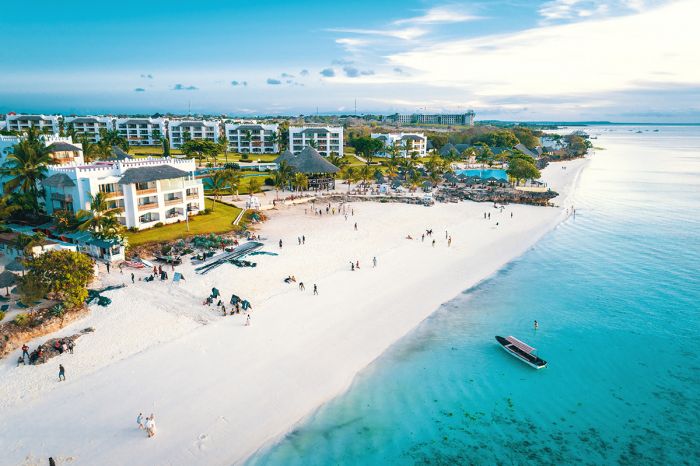
Nungwi Beach, Unguja Island, Zanzibar.
The eastern shoreline of Nungwi is mostly deserted and very peaceful, with no facilities besides a few upscale lodges, making it a romantic destination free from the hectic crowds across the public beaches of the peninsula.
Despite the bustling tourist industry, Nungwi itself is still a fishing village and traditional dhow-building is still a local specialty. The daily fish market is worth visiting when the fishing boats return and the romantic view of the traditional outrigger boats helps retain the old-world feel. The Ras Nungwi lighthouse was built in 1886 and the Mnarani Aquarium is also worth a visit. Cultural Village Tours are a good way to see everything with a knowledgeable guide.
ROOMS INCLUDES & EXCLUDES CHILDREN FACILITIES ACTIVITIES
Accommodation
12 guest accommodations in total comprising:
- 4 standard chalets.
- 6 triple chalets that have an upper mezzanine level with a full-size bed to accommodate a third guest.
- 2 pool chalets that have an outdoor plunge pool.
All the suites can be set up with a double bed or two twin beds and all include a private sea-facing veranda. The plumbed en-suite facilities include a deep bathtub, an indoor walk-in shower, a double-basin vanity, and flush toilet.
The suites are connected to the main lodge area by footpaths on the ground.
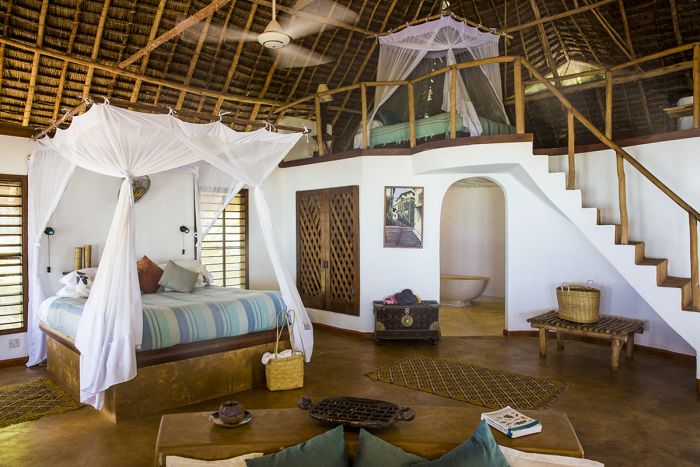
Guest chalet interior at Matemwe Lodge.
Matemwe Beach House
Matemwe Beach House is an exclusive-use two-bedroom (plus a mezzanine) villa located adjacent to Matemwe Lodge. The house is designed for a group or family traveling together and sleeps up to 6 guests (two of the beds are twins best used by children).
The two full bedrooms have double beds (convertible to twins) and each has its own en-suite facilities with a walk-in shower, twin-basin vanity, and flush toilet. The upper mezzanine level is accessed via stairs in the main entryway and has two twin beds. The beds have mosquito netting and all three sleeping spaces have ceiling fans. The house is fully air-conditioned.
Matemwe House features a dining room, a private chef, and a butler catering for the guests' every need. The spacious outdoor terrace includes lounge seating, and a swimming pool with pool loungers. The house has direct access to the sandy beach.
Guests staying at Matemwe Beach House have full access to all guest areas and amenities offered at Matemwe Lodge.
The main lodge areas and guest chalets are situated along the shoreline of the Indian Ocean in lush gardens with seaside views from the private verandas.
The chalets are constructed using earthen plaster on slightly elevated concrete flooring. The high-pitched ceilings are built using wooden beams and covered with a thatched roof.
Wooden shutter-doors lead onto the veranda and there are glass windows facing the sea to allow in natural light and views of the turquoise Indian Ocean.
Other items and features in the guest suites include:
- Writing desk and chair.
- Comfortable chaise and a hammock on the veranda.
- Tea / coffee station.
- Bathrobes.
- Wardrobe for clothes storage.
- Ceiling fan.
- Safe.
- Mosquito netting over the beds.
- Hairdryer.
- 24-hour power (provided via the electrical grid and a backup generator) for lighting and charging electronics.
- Wi-Fi available in the guest chalets and main guest areas.
- Mobile phone signal is reliable.
Matemwe Lodge can accommodate a maximum of 30 guests in total: 2 persons in each of the 12 guest chalets, a possible third guest in the 6 mezzanine chalets convertible to a triple.
Matemwe Private House is designed for a group or family traveling together and accommodates up to 6 guests.
Includes & Excludes
Includes:
- All meals (Matemwe Beach House).
- Breakfast and dinner (Matemwe Lodge).
- Tea, coffee, and filtered drinking water.
- Private butler and chef (Matemwe Beach House).
- Snorkeling excursions - one per guest (Matemwe Beach House).
- Guided reef walks.
- Kayaking.
- Guided cultural village walks.
- Laundry (Matemwe Beach House).
- Wi-Fi access (available in the guests chalets and main guest areas).
- Tourism Levy & all statutory taxes.
Excludes:
- Lunch (included for Matemwe Beach House).
- All drinks other than coffee and water.
- Additional activities: Stone Town walking tour, Jozani Forest tour, Zanzibar spice farm tour, boat excursions, deep-sea fishing, snorkeling excursions, scuba diving, jet-skiing, paddle boarding, kite-boarding, para-sailing, wake-boarding, knee-boarding, banana-boating, waterskiing, golfing.
- Laundry services (included at Matemwe Beach House).
- Spa treatments.
- Retail purchases at the Gift Shop.
- Any applicable wildlife fee, park fee, reserve fee, concession fee, other land-use fee (for excisions).
- Zanzibar Airport transfers (75 minutes by road).
Single Supplement
A single supplement may apply for any room booked by a single traveler; please ask us for pricing.
Children
Children aged 5 years and older are accommodated at Matemwe Lodge.
Children of any age are welcome at Matemwe Beach House.
- Six guest chalets at Matemwe Lodge available as a triple.
- Matemwe Beach House accommodates children of any age.
- Ask us about reduced rates for children sharing with adults or children 12-18 in their own suite.
- A range of child-focused activities is offered.
- Children's menu available.
Facilities
The main guest area at Matemwe Lodge consists of a spacious, open-air dining space and lounge under a high-pitched, thatched roof and offering views onto the Indian Ocean.
A wide variety of fresh and delicious cuisine is offered, with seafood being the specialty. Food is sourced from local fishermen and produce farms on the islands.
There are two bars, one of which is the 'Beach Bar', located at the edge of the white-sand beach adjacent to Matemwe Beach House. The spa and guest reception are a short stroll away.
The main swimming pool is multi-levels and partially nestled within the gardens under lofty palms and offering views onto the ocean. A second, smaller pool is located next to the poolside bar.
Matemwe's Water Sports Centre offers equipment and instruction for those looking to enjoy the myriad water sports offered at the resort. See more details below.
Guests staying at Matemwe Beach House and Matemwe Retreat have full access to all guest areas and amenities offered at Matemwe Lodge.
Main guest area facilities include:
- The main guest includes a dining area, lounge, swimming pool, and two bars (one at the pool and another beside the beach).
- Swimming pool and sun deck.
- Diving, snorkeling, and water sports Center.
- Gift Shop.
- Complimentary Wi-Fi access.
- Mineral water is provided in the main lodge areas.
- The lodge is powered by the electrical grid and has a backup generator.
Activities
There are a seemingly endless range of activities offered in Zanzibar, some offered directly at the lodge and many more offered via local tour operators.
Activities included in the rate:
- Guided reef walks: Learn about the smaller, slimier sea creatures.
- Kayaking: A gentle paddle or a strenuous adventure, it’s up to you.
- Guided cultural village walks.
- Snorkeling excursions - one per guest (Matemwe Beach House).
Optional activities at additional cost:
Family Activities
- Escape to Infinity or Muyuni Beach: Your family’s own private beach.
- SUP-rise: Learn how to stand-up paddle-board at sunrise.
- Matemwe Village Trip: Visit a school and play football with local children.
- Jozani Forest Tour: Explore the island’s only remaining natural forest.
- Nine-hole Golf Course: Enjoy Zanzibar’s only golf course.
Romance Activities
- Snorkeling Excursion to Mnemba Reef: Explore the underwater world.
- Ngalawa Sailing: Cruise along the coastline in a traditional dhow.
- Escape to Infinity or Muyuni Beach: Your own private beach with a bottle of bubbly.
- Guided Mangrove Tour: A SUP tour of these fascinating forests.
- Catamaran Sunset Cruise: Picture-perfect sundowners.
- The Spa at Matemwe: Enjoy a couple’s massage with a view of the Mnemba Atoll.
Thrill-seeker Activities
- Kayaking: A gentle paddle or a strenuous adventure, it’s up to you.
- Diving: Try the wrecks for the ultimate adventure.
- Deep-sea Fishing: Whether you’re a novice or a pro, you have a chance of catching a record-breaker.
- Kitesurfing: Give the latest high-adrenaline sport a go.
- Water Sports: Try jet-skiing, paddle-boarding, kite-boarding, para-sailing, wake-boarding, knee-boarding, banana-boating, waterskiing, and more.
Cultural Activities
- Spice Tour: Discover many of the alternative uses for Zanzibar’s famous spices.
- Historical Stone Town and Prison Island Tour: Explore the melting pot of cultures that is Stone Town, then step back in time with a visit to beautiful Prison Island.
- Swahili Cooking Lesson: Learn how to recreate authentic Zanzibari dishes at home.
- Matemwe Village Walk: A glimpse into local life in the village.
Great Good Fair Poor
- Jan
- Feb
- Mar
- Apr
- May
- Jun
- Jul
- Aug
- Sep
- Oct
- Nov
- Dec
General Tips
The best time to visit Zanzibar is from June to October, which is the dry season. The same weather patterns of affect most of northern Tanzania, so combining Zanzibar with a safari works quite well in terms of seasonal rainfall. Most visitors prefer to do the safari portion of the trip first, followed by the tropical beaches and air of Zanzibar.
Besides for the period during the 'long rains', which is March through much of May, Zanzibar can be visited at any time.
Matemwe Lodge and Matemwe Beach House are closed from 01 April thru 31 May.
RAINS
The rainy season in northern Tanzania is from November thru mid-May, with two distinct rain seasons. The "Short Rains" (locally called the "mvuli") fall from mid-November to mid-December and are generally lighter and less impactful to safari activities. The "Long Rains" (locally called the "masika") occur between March and May, brining afternoon showers on a near daily basis.
Short Rains
The short rains occur for about one month sometime during November and December (the exact time varied somewhat year to year). This period is called the 'short' rains because the duration of an individual rain event is short and it is rare to have an all-day rain event. Most rain falls as an afternoon shower, while mornings are typically overcast or clear.
Long Rains
The long rains occur between March and May, with April being the wettest month of the year. During this time, rain should be expected almost every day and the showers can last for hours at a time, although all-day rain is not typical. Cloudy skies are typical and temperatures can be chilly at times.
The period between the short and long rains (January and February) also receives rainfall, but many days are clear and the amount and duration of the rain events is unpredictable, with some afternoon showers and the odd long and heavy shower.
Jul through September (as well as February) are the months receiving the least amount of rainfall, but rain can occur at any time during there year in Zanzibar. April and May are by far the wettest months.
Some beach resorts and hotels are closed for some or all of the long rains from March thru May.
Temperatures
The islands of Zanzibar are warm all year due to their close proximity to the equator (between 5 and 6 degrees south). Over the year, the days average a low of 75°F (24°C) and a high of 84°F (29°C).
November through March are the warmest months of the year, with daytime temps reaching an average high of 90-94°F (32-34°C) and falling to 71-74°F (22-24°C) overnight. June through August experience slightly cooler temps, with days averaging a high of 85-86°F (29-30°C) and nighttime temps averaging 69-71°F (20-21°C).
Diving & Snorkeling
The water temperature around the Zanzibar Archipelago averages 79-81°F (26-27°C) throughout the year and underwater visibility averages 65-165 feet (20-50 meters). There are numerous offshore reefs all around the Zanzibari islands and it is a great diving and snorkeling destination throughout most of the year.
The best time to visit northern Zanzibar for diving and snorkeling is from June to October, while the south coast is great between November and March.
The nearby Mnemba Island is a small above-water piece of the much larger Mnemba Atoll, which offers excellent diving and snorkeling. The months of September through December are very good for sea turtles, dolphins and whale sharks, but the reefs offers superb marine life viewing all year.




